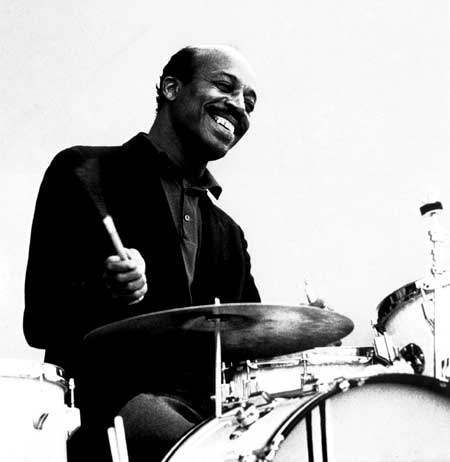 A simple experiment
A simple experimentRecently I noticed something peculiar about my comping with brushes. Depending on what rhythm I was comping, I would change my left hand sweeping pattern. As with any discussion about brushes, this sounds more complicated than it actually is. I suggest that you grab a pair of brushes and try the following experiment:
1. Play your regular brush pattern and comp on the "+" of 1 with your left hand- does that feel comfortable?
2. Try the same thing but comp on the "+" of 2- does that feel comfortable?
I have found that depending on how you hold the brush and what direction you sweep in, one of the two comping rhythms above will be significantly easier to execute than the other. For me, comping on the "+" of 1 feels totally natural while the "+" of 2 does not.
People tend to address this challenge in one of two ways, either they change their left hand sweeping pattern so that they comp the uncomfortable rhythm in a direction that is comfortable, or they just play the comping rhythm in their right hand. Often times people (myself included) just cobble together some combination of these two approaches to find something that works.
Integrating comping into your sweeping pattern
Of course, there is absolutely nothing wrong with finding something that works and sticking with it! Recently however, I found myself feeling constrained by my brush comping. I wanted to find a way to expand my rhythmic palette to make it feel more like comping with sticks. I quickly realized that the most direct way to make my brush comping feel more like stick comping was to tackle the issue of integrating my comping into my sweeping pattern. That is to say, learning to comp in whatever direction my left hand was naturally moving in.
Those of you who are familiar with this blog know that I am a huge advocate of making every exercise as close to musical as possible. With that in mind I came up with the following system:
1. Practice only comping in your awkward direction with just your left hand
Before you do anything else with this, you have to work out the physical motion of your left hand that will achieve the comping sound you want without breaking up your sweeping. This is more challenging than it sounds. For example, I noticed that I put a little extra pressure on beats 2 and 4 in my left hand sweeping pattern. So being able to release this pressure and get my fingers to snap the brush without breaking up the sweep entirely was hard. What ended up working was thinking of the motion as the reverse of what I normally do on the "+" of 1. So if I normally snapped my fingers out on that beat, I had to try to get a similar sound by snapping my fingers in on the "+" of beat 2. Although this step can be really boring, don't skip it. Everything after this will depend on your ability to get a good comping sound in your left hand.
2. Practice only comping in your awkward direction with music
Now that your left hand is feeling at least reasonably good, it is time to get to the music. For this exercise I highly recommend the song "Lorelei" from the Bill Charlap album "Written In the Stars". Kenny Washington is playing drums on this album, and his brush sound, combined with the tempo and feel of this song, make it a perfect one to practice along with.
For this step, simply practice playing time and comping consistently in your awkward direction. For me this meant comping on the "+" of beats 2 and 4. Don't worry about referencing the song too much in your playing at this point, just focus on getting a good sound and locking up with the bass player (the fantastic Peter Washington) Here is what that will sound like with the melody:
Stay tuned for the second half of this exercise coming soon!




